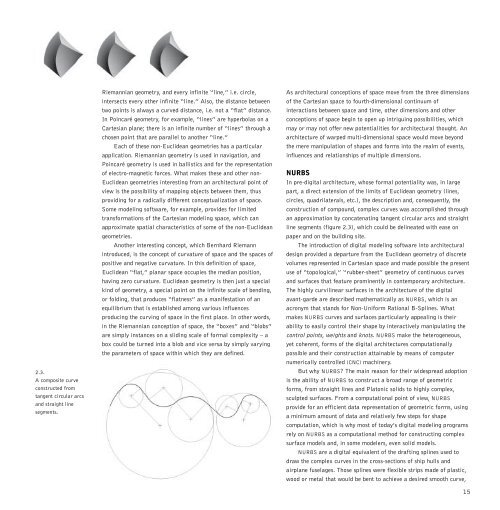02 Digital Morphogenesis - iMADE
02 Digital Morphogenesis - iMADE
02 Digital Morphogenesis - iMADE
Create successful ePaper yourself
Turn your PDF publications into a flip-book with our unique Google optimized e-Paper software.
2.3.<br />
A composite curve<br />
constructed from<br />
tangent circular arcs<br />
and straight line<br />
segments.<br />
Riemannian geometry, and every infinite “line,” i.e. circle,<br />
intersects every other infinite “line.” Also, the distance between<br />
two points is always a curved distance, i.e. not a “flat” distance.<br />
In Poincaré geometry, for example, “lines” are hyperbolas on a<br />
Cartesian plane; there is an infinite number of “lines” through a<br />
chosen point that are parallel to another “line.”<br />
Each of these non-Euclidean geometries has a particular<br />
application. Riemannian geometry is used in navigation, and<br />
Poincaré geometry is used in ballistics and for the representation<br />
of electro-magnetic forces. What makes these and other non-<br />
Euclidean geometries interesting from an architectural point of<br />
view is the possibility of mapping objects between them, thus<br />
providing for a radically different conceptualization of space.<br />
Some modeling software, for example, provides for limited<br />
transformations of the Cartesian modeling space, which can<br />
approximate spatial characteristics of some of the non-Euclidean<br />
geometries.<br />
Another interesting concept, which Bernhard Riemann<br />
introduced, is the concept of curvature of space and the spaces of<br />
positive and negative curvature. In this definition of space,<br />
Euclidean “flat,” planar space occupies the median position,<br />
having zero curvature. Euclidean geometry is then just a special<br />
kind of geometry, a special point on the infinite scale of bending,<br />
or folding, that produces “flatness” as a manifestation of an<br />
equilibrium that is established among various influences<br />
producing the curving of space in the first place. In other words,<br />
in the Riemannian conception of space, the “boxes” and “blobs”<br />
are simply instances on a sliding scale of formal complexity – a<br />
box could be turned into a blob and vice versa by simply varying<br />
the parameters of space within which they are defined.<br />
As architectural conceptions of space move from the three dimensions<br />
of the Cartesian space to fourth-dimensional continuum of<br />
interactions between space and time, other dimensions and other<br />
conceptions of space begin to open up intriguing possibilities, which<br />
may or may not offer new potentialities for architectural thought. An<br />
architecture of warped multi-dimensional space would move beyond<br />
the mere manipulation of shapes and forms into the realm of events,<br />
influences and relationships of multiple dimensions.<br />
NURBS<br />
In pre-digital architecture, whose formal potentiality was, in large<br />
part, a direct extension of the limits of Euclidean geometry (lines,<br />
circles, quadrilaterals, etc.), the description and, consequently, the<br />
construction of compound, complex curves was accomplished through<br />
an approximation by concatenating tangent circular arcs and straight<br />
line segments (figure 2.3), which could be delineated with ease on<br />
paper and on the building site.<br />
The introduction of digital modeling software into architectural<br />
design provided a departure from the Euclidean geometry of discrete<br />
volumes represented in Cartesian space and made possible the present<br />
use of “topological,” “rubber-sheet” geometry of continuous curves<br />
and surfaces that feature prominently in contemporary architecture.<br />
The highly curvilinear surfaces in the architecture of the digital<br />
avant-garde are described mathematically as NURBS, which is an<br />
acronym that stands for Non-Uniform Rational B-Splines. What<br />
makes NURBS curves and surfaces particularly appealing is their<br />
ability to easily control their shape by interactively manipulating the<br />
control points, weights and knots. NURBS make the heterogeneous,<br />
yet coherent, forms of the digital architectures computationally<br />
possible and their construction attainable by means of computer<br />
numerically controlled (CNC) machinery.<br />
But why NURBS? The main reason for their widespread adoption<br />
is the ability of NURBS to construct a broad range of geometric<br />
forms, from straight lines and Platonic solids to highly complex,<br />
sculpted surfaces. From a computational point of view, NURBS<br />
provide for an efficient data representation of geometric forms, using<br />
a minimum amount of data and relatively few steps for shape<br />
computation, which is why most of today’s digital modeling programs<br />
rely on NURBS as a computational method for constructing complex<br />
surface models and, in some modelers, even solid models.<br />
NURBS are a digital equivalent of the drafting splines used to<br />
draw the complex curves in the cross-sections of ship hulls and<br />
airplane fuselages. Those splines were flexible strips made of plastic,<br />
wood or metal that would be bent to achieve a desired smooth curve,<br />
15


